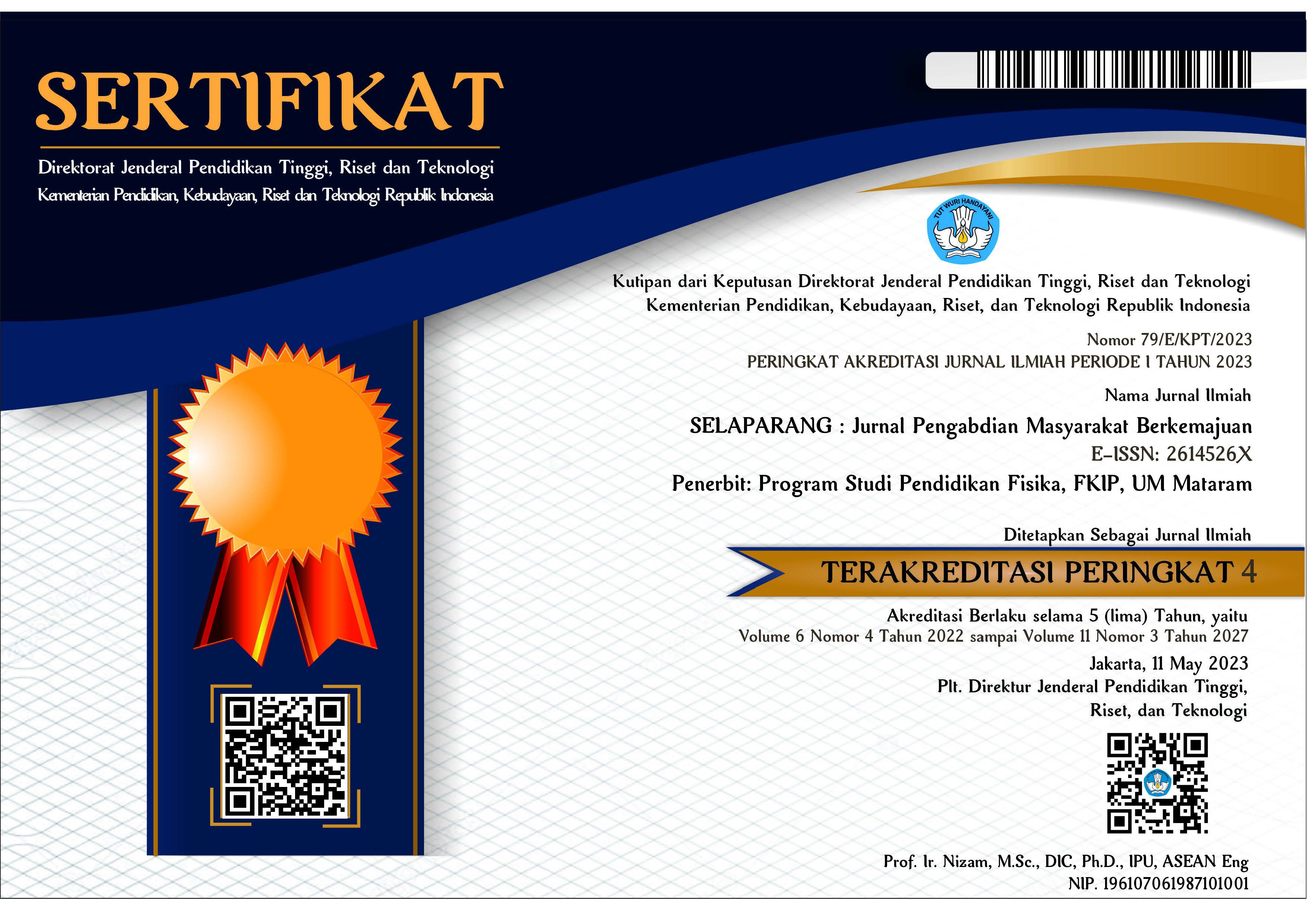Pemberdayaan apoteker dalam pemberian layanan telemedicine tentang sexual transmission infection
Abstract
Abstrak
Infeksi Menular Seksual (IMS) adalah penyakit infeksi penularan suatu organisme antara pasangan seksual melalui berbagai kontak dengan cairan tubuh atau kulit saat berhubungan intim melalui seks vagina, oral dan anal, dengan tingkat mortalitas yang tinggi. Salah satu kontributor IMS, adalah di Nusa Tenggara Barat dengan jumlah estimasi orang dengan resiko terinfeksi HIV sebesar 284.909 jiwa. Namun, hanya sebanyak 16,31% yang mendapatkan pelayanan sesuai standar. Salah satu upaya yang dapat dilakukan untuk mencegah IMS adalah dengan meningkatkan kesadaran melalui pelayanan telemedicine. Tujuan pengabdian ini adalah untuk membangun platform telemedicine sebagai media edukasi dan interaksi serta melatih apoteker sebagai pelaksana edukasi IMS ke masyarakat. Kegiatan ini dilakukan dengan melibatkan sosialisasi melalui akun Instragram, Youtube, dan website khusus. Sosialisasi dilakukan kepada para apoteker dari Ikatan Apoteker Indonesia (IAI) Mataram dan Lombok Tengah. Program pelatihan meliputi sesi edukasi IMS, pembuatan media edukasi (poster dan video), dan pembuatan website interaktif. Pelatihan mitra apoteker diikuti oleh 12 anggota dari masing-masing anggota Mataram dan Lombok Tengah. Terdapat hasil dan luaran yang diharapkan dari pengabdian yang telah dilakukan yaitu poster dan video edukasi IMS, publikasi berita di media lokal, platform telemedicine berupa Instagram, website, dan Youtube, serta peningkatan kemampuan peserta dan kesiapan para apoteker dalam menerapkan edukasi IMS (Infeksi Menular Seksual). Program ini dirancang untuk meningkatkan kapasitas apoteker dalam memberikan edukasi melewati telemedicine. Hal ini ditunjukkan dengan adanya peningkatan pengetahuan oleh apoteker dari sebelum dan setelah pelatihan berdasarkan skort es (p <0,05) dan jumlah pendaftar apoteker yang meningkat hingga 38 akun di website.
Kata kunci: apoteker; telemedicine; infeksi menular seksual
Abstract
Sexually Transmitted Infections (STIs) are infectious diseases transmitted by an organism between sexual partners through various contacts with body fluids or skin during intercourse through vaginal, oral and anal sex, with a high mortality rate. One of the contributors to STIs is in West Nusa Tenggara with 284,909 people estimated number of people at risk of HIV infection. However, only 16.31% people at risk received standard services. One effort that can be made to prevent STIs is to increase awareness through telemedicine services. The purpose of this service is to build a telemedicine platform as a medium for education and interaction and to train pharmacists as implementers of STI education to the community. This activity is carried out by involving socialization through Instagram accounts, Youtube, and special websites. Socialization was carried out to pharmacists from the Indonesian Pharmacists Association (IAI) Mataram and Central Lombok. The training program includes STI education sessions, making educational media (posters and videos), and making interactive websites. The pharmacist partner training was attended by 12 members from each member of Mataram and Central Lombok. There are expected results and outputs from the service that has been carried out, namely posters and educational videos on STIs, publications in local media, telemedicine platforms in the form of Instagram, websites, and Youtube, as well as increasing the ability of participants and the readiness of pharmacists in implementing STIs (Sexually Transmitted Infections) education. This program is designed to improve the capacity of pharmacists in providing education through telemedicine. This is indicated by an increase in knowledge by pharmacists before and after training based on the es score (p <0.05) and the number of pharmacist registrants increasing to 38 accounts on the website.
Keywords: pharmacist; telemedicine; sexual transmiited infections
Keywords
Full Text:
PDFReferences
Baldoni, S., Amenta, F., & Ricci, G. (2019). Telepharmacy services: Present status and future perspectives: A review. In Medicina (Lithuania) (Vol. 55, Issue 7). MDPI AG. https://doi.org/10.3390/medicina55070327
Fasciana, T., Capra, G., Lipari, D., Firenze, A., & Giammanco, A. (2022). Sexually Transmitted Diseases: Diagnosis and Control. In International Journal of Environmental Research and Public Health (Vol. 19, Issue 9). MDPI. https://doi.org/10.3390/ijerph19095293
Kemenkes RI. (2020). Surat Edaran Nomor Hk.02.01/Menkes/303/2020 Tentang Penyelenggaraan Pelayanan Kesehatan Melalui Pemanfaatan Teknologi Informasi Dan Komunikasi Dalam Rangka Pencegahan Penyebaran Corona Virus Disease 2019 (COVID-19).
Kemenkes RI. (2021). Peraturan Menteri Kesehatan Republik Indonesia No. 14 Tahun 2021 Tentang Standar Kegiatan Usaha Dan Produk Pada Penyelenggaraan Perizinan Berusaha Berbasis Risiko Sektor Kesehatan.
Kemenkes RI. (2022). Laporan Kinerja 2022.
Le, T., Toscani, M., & Colaizzi, J. (2020). Telepharmacy: A New Paradigm for Our Profession. In Journal of Pharmacy Practice (Vol. 33, Issue 2, pp. 176–182). SAGE Publications Inc. https://doi.org/10.1177/0897190018791060
Nyati, A., Gupta, S., Jain, S. K., Yadav, D., Patidar, B. L., & Sharma, M. (2017). A retrospective study of the pattern of sexually transmitted infections from a tertiary care hospital of Rajasthan. Indian Journal of Sexually Transmitted Diseases, 38(2), 147–151. https://doi.org/10.4103/ijstd.IJSTD_82_16
Poudel, A., & Nissen, L. (2016). Telepharmacy: a pharmacist’s perspective on the clinical benefits and challenges. Integrated Pharmacy Research and Practice, Volume 5, 75–82. https://doi.org/10.2147/iprp.s101685
Silva, R. de O. S., de Araújo, D. C. S. A., dos Santos Menezes, P. W., Neves, E. R. Z., & de Lyra, D. P. (2022). Digital pharmacists: the new wave in pharmacy practice and education. In International Journal of Clinical Pharmacy (Vol. 44, Issue 3, pp. 775–780). Springer Science and Business Media Deutschland GmbH. https://doi.org/10.1007/s11096-021-01365-5
Valentine, J. A., Mena, L., & Millett, G. (2022). Telehealth Services: Implications for Enhancing Sexually Transmitted Infection Prevention. Sexually Transmitted Diseases, 49(11), S36–S40. https://doi.org/10.1097/OLQ.0000000000001699
WHO. (2021). Sexually Transmitted Infections 2016-2021.
Windari, M. M. (2015). Pencegahan Penularan Infeksi Menular Seksual dan Human Immunodeficiency Virus. In Rogram Pendidikan Dokter Spesialis I Bagian/Smf Ilmu Kesehatan Kulit dan Kelamin Fakultas Kedokteran Unud/Rsup Sanglah Denpasar.
DOI: https://doi.org/10.31764/jpmb.v8i4.28663
Refbacks
- There are currently no refbacks.

This work is licensed under a Creative Commons Attribution-ShareAlike 4.0 International License.
______________________________________________________
Jurnal Selaparang
p-ISSN 2614-5251 || e-ISSN 2614-526X
EDITORIAL OFFICE:



















